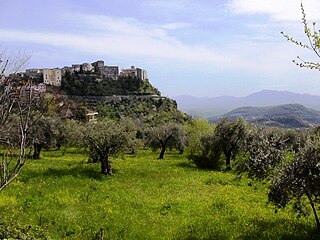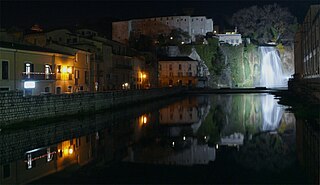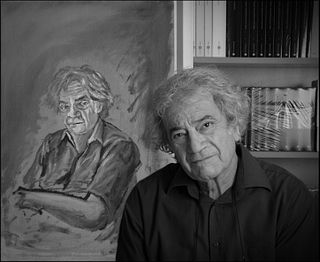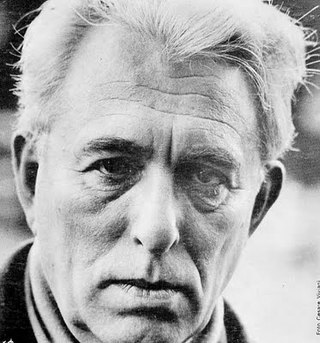
Giovanni Fontana (born 1946) is an Italian poet, performance artist, author and publisher.

Giovanni Fontana (born 1946) is an Italian poet, performance artist, author and publisher.
Fontana was born in Frosinone, Lazio. He has been dealing for forty years with multi-code languages, intermedia techniques, sound poetry and visual poetry. [1] [2]
Interested in the relationship between the arts, he came to a new conception of text and theorized the concepts of "pre-textual poetry" and the "epigenetic poetry". [1] [2] His visual compositions present themselves as real scores, as pre-texts through which to attain a performance dimension. [2] [3] From the latter half of the 1960s he has experience of theatre with the dramatic art groups. In 1968 he founded a small experimental theatre company. For theatre he wrote texts and he also worked as scenographer and musician. [1] His first visual poems are dated around the years of 1966–1968 and they develop parallel to sound experimentations on magnetic tape, which later were used in theatre (1968–1972). [2]
Fontana has published books and records. Among his works are the score-text Radio/Dramma (1977), the visual poetry works Le lamie del labirinto (1981) [4] and L'uomo delle pulizie (1984), the collection of poetry Scritture lineari (1986), the poems La discarica fluente (1997), Frammenti d'ombre e penombre (2005), Questioni di scarti (2012), the monograph Testi e pre-testi (2010) and two novels: Tarocco Meccanico (1990) and Chorus (2000). Fontana wrote theoretical and critical essays, including "La voce in movimento" (2003), "Poesia della voce e del gesto" (2004), "Le dinamiche nomadi della performance" (2006), "L'opera plurale" (2009).
Fontana was the curator of the CD Verbivocovisual. Antologia di poesia sonora 1964–2004 for the magazine Il Verri ; he founded La Taverna di Auerbach, an international magazine of intermedial poetics, and the magazine of sound poetry Momo (voci, suoni & rumori della poesia), and he is an editor of the audiomagazine Baobab. [2] With his visual poems he took part in many exhibitions in Europe, in the Americas, in Japan and Australia, giving performances and installations in thousands of festivals for new poetry and electronic art. [5]
Frosinone is a town and comune in Lazio, central Italy, the administrative seat of the province of Frosinone. It is located about 75 kilometres (47 mi) south-east of Rome close to the Rome-Naples A1 Motorway. The city is the main city of the Valle Latina, an Italian geographical and historical region that extends from south of Rome to Cassino.

Alatri is an Italian town and comune of the province of Frosinone in the region of Lazio, with c. 30,000 inhabitants. An ancient city of the Hernici, it is known for its megalithic acropolis.

Veroli is a town and comune in the province of Frosinone, Lazio, central Italy, in the Latin Valley.

Biagio Marin (1891–1985) was a Venetian poet, best known for his poems in the Venetian language, which had no literary tradition until then. In his writings he never obeyed rhetoric or poetics. He only employed a few hundred words for his poems.

The Roman Catholic diocese of Ferentino existed until 1986, when it was united into the new diocese of Frosinone-Veroli-Ferentino.
In Italian literature some folkloric words like Ciociaria and ciociari are used to denote people, film settings, and characters in Italian neorealist works.
Angela Bianchini was an Italian fiction writer and literary critic of Jewish descent. She grew up in Italy and emigrated to the United States in 1941, after Mussolini's openly anti-Semitic racial laws were enacted.
Caterina Davinio is an Italian poet, novelist and new media artist. She is the author of works of digital art, net.art, video art and was the creator of Italian Net-poetry in 1998.

Gianni Toti was an Italian poet, writer, journalist, and cineaste. In the early 80s he created "Poetronica".

Giorgio Caproni was an Italian poet, literary critic and translator, especially from French. His work was also part of the literature event in the art competition at the 1948 Summer Olympics.

Valle Latina is an Italian geographical and historical region that extends from the south of Rome to Cassino, corresponding to the eastern area of ancient Roman Latium.
Lello Voce is an Italian poet, writer, and journalist. He was among the founders of Gruppo 93 and of the six-monthly literary magazine Baldus. He lives and works in Treviso, Veneto.

Beppe Costa is an Italian poet, novelist and publisher.

Franco Fortini was the pseudonym of Franco Lattes, an Italian poet, writer, translator, essayist, literary critic and Marxist intellectual.

The Gottifredo Palace is a large medieval house in Alatri in the Lazio Region of Italy. It lies at the confluence of the main streets of Alatri at the time of the palace's construction: the first, coming from the north city gate of San Pietro; the second, from west, arrives from the ancient Via San Francesco which passes through the gate of the same name; the third from gate St Nicholas, to the east.
The gosos or goccius are a kind of devotional and paraliturgical songs of Iberian origin typical of Sardinia, and written in the Sardinian language.

Franco Loi was an Italian poet, writer, and essayist. He was born in Genoa, and died in Milan, aged 90. He made his debut in 1973 as a poet using dialect and had a good success with the work I cart, and the following year, 1974, with Poems of love. In 1975 the poet proves to have reached complete maturity of expression with the poem Stròlegh, published by Einaudi with a preface by Franco Fortini. In 1978 Einaudi published the collection Teater and in 1981 the work L'Angel followed by Edizioni San Marco dei Giustiniani. Also in 1981, thanks to the collection L'aria, he won the "Lanciano" national prize for dialectal poetry. In 2005 he published L'aria de la memoria for Einaudi, in which he collected all the poems written between 1973 and 2002. He has been Honorary President of the Contemporary Arts Centre of Cilento and Milan founded in 2019 by Menotti Lerro, and, starting from 2020, member of the Empathic School Movement / Empathism. In 2019 he won the Cilento Poetry Prize conferred to him at Accademia di Belle Arti di Brera.
Tiziano Rossi is an Italian poet. He is well known for his published books of poetry, but in 2020 he also published a collection of short tales.

Omero Vecchi, known by his pen name Luciano Folgore, was an Italian poet.
Corrado Govoni. was an Italian poet. His work dealt with modern urban representations, the states of memory, nostalgia, and longing, using an expressive and evocative style of writing.